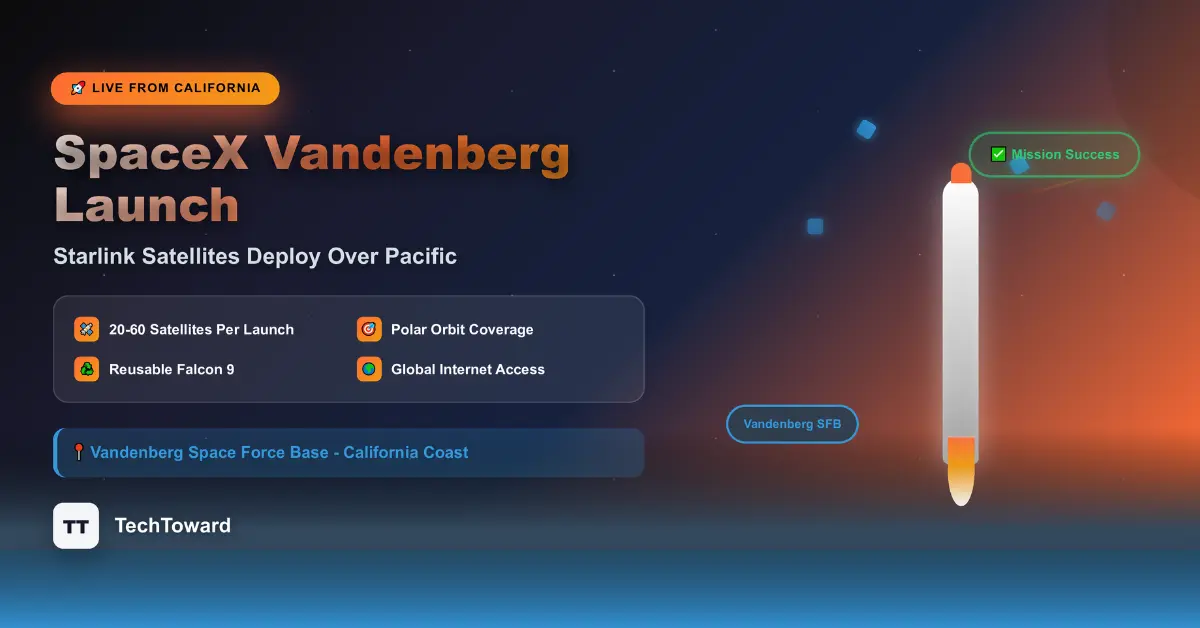SpaceX’s Starlink launches from Vandenberg Space Force Base may seem routine, but each mission plays a crucial role in building a revolutionary global internet system. Understanding how these launches work, why Vandenberg is key, and how Starlink changes lives helps you see the future of connectivity unfolding in real time.
What Is SpaceX Doing at Vandenberg?
Founded by Elon Musk, SpaceX frequently launches Starlink satellites from Vandenberg Space Force Base on California’s coast. Vandenberg is ideal for reaching polar and sun-synchronous orbits, which are needed to provide global internet coverage.
The Starlink project aims to create a massive constellation of satellites in low Earth orbit (LEO)—about 340–550 km above Earth. At these lower altitudes, signals travel faster compared to traditional geostationary satellites at 35,000 km, delivering low-latency, high-speed internet.
As of 2025, thousands of Starlink satellites are already in orbit, serving millions of users from rural America to Antarctica. Plans call for tens of thousands more, ensuring reliable global coverage.
Why Vandenberg, California?
Vandenberg isn’t just scenic—it’s strategic.
- Polar orbit access: Launching south over the Pacific avoids populated areas and enables coverage of polar regions.
- Safety: Ocean trajectories minimize risks to communities.
- Weather: California’s mild climate supports frequent launches.
- Infrastructure: Decades of aerospace development provide top-tier facilities.
Vandenberg complements Cape Canaveral in Florida, which handles equatorial launches. By using both coasts, SpaceX can build out its constellation more efficiently.
How a Starlink Launch Works
Step 1: Pre-Launch
Satellites are integrated into the Falcon 9 rocket. Engineers inspect hardware, load RP-1 kerosene and liquid oxygen, and confirm weather readiness.
Step 2: Liftoff
Falcon 9’s nine Merlin engines ignite, generating 1.7 million pounds of thrust. From Vandenberg, rockets head south, often producing spectacular twilight “space jellyfish” displays.
Step 3: Stage Separation & Booster Recovery
After 2.5 minutes, the first stage separates. SpaceX lands it back on a drone ship or at Vandenberg’s Landing Zone 4—a breakthrough in reusable rocketry, reducing launch costs from ~$200 million to ~$30–50 million.
Step 4: Satellite Deployment
The second stage releases the satellites about 15 minutes into flight. Each uses ion thrusters to maneuver into final orbit.
Step 5: Operations
Satellites unfold solar arrays, activate antennas, and link with ground stations. Equipped with collision avoidance and autonomous navigation, they adjust orbits to ensure safety.
Who Benefits?
Rural Communities
Teachers, farmers, and families in remote areas gain speeds of 100+ Mbps, making modern digital work and learning possible.
Disaster Response
In crises like Hurricane Ian (2022) or earthquakes in Turkey, Starlink provided emergency internet when local infrastructure failed.
Maritime & Aviation
Ships and airplanes now enjoy in-transit high-speed connectivity, once impossible in remote locations.
Research
Antarctic scientists can transmit data, video-call families, and collaborate globally—thanks to Starlink.
Starlink Satellite Technology
Advanced Features
- Laser links: Satellites beam data to each other at light speed, reducing dependence on ground stations.
- Autonomous navigation: Satellites self-adjust using GPS and star trackers.
- End-of-life disposal: After 5–7 years, satellites safely de-orbit.
- Reduced brightness: Coatings and sunshades minimize interference with astronomy.
Network Design
Starlink operates as a mesh network. Your dish connects to the nearest satellite, which relays data to ground stations or via laser links across satellites. Latency averages 20–40 ms, rivaling fiber internet and far outperforming traditional satellite internet (>600 ms).
Environmental & Space Concerns
Rocket Emissions
Each Falcon 9 launch emits 400–500 tons of CO₂ equivalent—comparable to a transatlantic flight. Reusability reduces manufacturing emissions, and the upcoming Starship rocket may run on methane and oxygen, potentially using renewable production methods.
Space Traffic
SpaceX addresses congestion with:
- Autonomous avoidance maneuvers
- Low orbits that naturally decay
- Coordination with regulators like the FCC
- Debris transparency through published orbital dat
Astronomical groups continue to collaborate with SpaceX on minimizing satellite brightness.
Economics of Starlink Launches
Revenue
Starlink could generate $30–50 billion annually, outpacing launch services. Profits fund projects like Mars colonization, Moon missions, and Earth point-to-point travel via Starship.
Market Impact
Traditional providers charged $200+ for poor service. Starlink’s $110–120 per month reshapes the market, forcing competitors to innovate.
Strategic Value
Starlink has major geopolitical implications. The U.S. military embraces it, while some countries restrict or ban it over concerns of foreign-controlled networks.
Also, SpaceX’s ability to regularly launch many satellites and land boosters is a key strength. For example, read how Elon Musk’s SpaceX launches 24 Starlinks and lands rockets on ships in this related article.
Watching a Launch from Vandenberg
Viewing Spots
- Surf Beach (closest public access)
- Ocean Avenue in Lompoc
- Jalama Beach County Park
- Highway 1 pullouts
Tips
Bring binoculars, cameras, warm clothes, and patience—launch delays are common. Twilight launches produce the most breathtaking visuals.
Schedules
Check:
- SpaceX’s official launch page
- Space launch calendars online
The Future of Vandenberg Starlink Launches
Starlink V3
Future satellites will be larger, with 10–20× bandwidth, requiring Starship’s heavy-lift capacity.
Higher Cadence
With investments in new pads and facilities, Vandenberg could see launches every few days.
Competitors
Amazon’s Project Kuiper, OneWeb, and Chinese constellations are racing to compete, but SpaceX’s head start and reusability advantage put it far ahead.
FAQs
Why launch from Vandenberg?
Its coastal position enables safe polar-orbit launches for global coverage.
How many satellites per launch?
Falcon 9 carries 20–60; Starship will carry 100+.
Can the public see launches?
Yes—coastal vantage points offer excellent views, especially at twilight.
How are boosters recovered?
Falcon 9 lands on a drone ship or at Vandenberg’s landing zone.
What makes Starlink different?
Low orbits cut latency from 600+ ms to 20–40 ms, making real-time uses like gaming and video calls possible.
How much does it cost?
Residential plans cost $110–120/month, plus ~$599 hardware.
Are satellites safe?
Yes—autonomous systems avoid collisions, and all satellites de-orbit at end-of-life.
Where is Starlink available?
As of 2025, in 60+ countries and expanding.
Final Words
SpaceX’s Vandenberg launches are more than routine—they’re building the world’s most ambitious communication network. Each Falcon 9 sends dozens of satellites into orbit, incrementally closing the global digital divide.
From remote teachers and emergency responders to scientists and travelers, millions already rely on Starlink. Meanwhile, reusable rockets, inter-satellite lasers, and autonomous constellations are reshaping space technology and economics.
The next time you see a rocket streak across California’s sky, you’re watching the infrastructure of the future—one that brings high-speed connectivity to every corner of Earth. Starlink is not just about space—it’s about connecting humanity.


